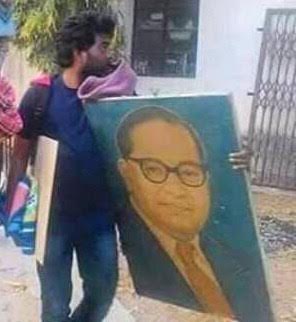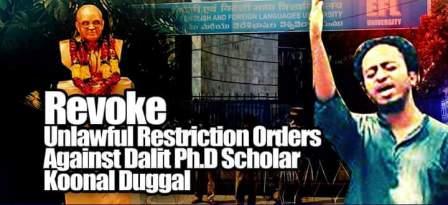Mohammad Imran
 The recently conducted rally in Aurangabad by Advocate Prakash Ambedkar, in which the alliance between Bharipa Bahujan Mahasangh and Assaduddin Owaisi led All India Majlis-e-Ittehadul Muslimeen was formally announced was a much debated political move in Maharashtrian politics. The alliance was made on the ground that it has an ability to speak up on behalf of two major discriminated communities of the current era. It was also felt by many of the supporters of both parties that it may benefit both of the communities (Bahujans-Muslims) in the longer run. But for me, this move is purely political rather than an ideological one because there is no anti-caste element in it.
The recently conducted rally in Aurangabad by Advocate Prakash Ambedkar, in which the alliance between Bharipa Bahujan Mahasangh and Assaduddin Owaisi led All India Majlis-e-Ittehadul Muslimeen was formally announced was a much debated political move in Maharashtrian politics. The alliance was made on the ground that it has an ability to speak up on behalf of two major discriminated communities of the current era. It was also felt by many of the supporters of both parties that it may benefit both of the communities (Bahujans-Muslims) in the longer run. But for me, this move is purely political rather than an ideological one because there is no anti-caste element in it.
The slogan of Jai Bhim has always been a slogan for anti-caste emancipatory movements with special reference to Babasaheb Ambedkar. This slogan has its own history, trajectory and impact on the Bahujan community for reclaiming their rights and asserting their voices. But the mixing (aligning) of it with a religious identity is problematic in several ways. The problem is not only in an ideological sense but it has political effects too. With special reference to the growing Pasmanda movement, I would like to place my arguments on why such alignments can’t work in the long run in an ideological cum political manner.
Among the Indian Muslims, there are almost 246 communities (castes and tribes) out of which the Pasmanda (Ajlafs plus Arzals) contribute more than three-fourths. In its essence, Islam didn’t promote any sort of identity-based inequality. Despite its non-Brahmanical orientation, converts to Islam were not able to part away from the caste and caste-based institutions. The converts not only maintained the caste system but also legitimised it through multiple ways via religious scriptures. Currently, Indian Muslims are divided into three broad categories Ashraf (upper caste), Ajlafs (OBC/occupational castes), and Arzals (Dalits/Untouchables). The Sachar Committee report has clearly mentioned the socio-economic inequality between these groups and various literatures based upon Pasmanda Movement have clearly shown up the political partiality towards the lower caste Muslims. The democratization of the Muslim society has not occurred till now since the upper caste leadership has consciously focused on the politics of Muslim identity and centered a few cultural, emotive issues. Such politics not only portrayed Indian Muslims as a ‘uniform monolithic community’ but also hid caste-ridden and fragmented realities of the community.
Now I would like to contextualise my arguments about the recent alliance and why it is a doubled edge weapon (Do Dhari Talwaar) for lower caste Muslims. The problematics of this alliance is two fold i.e. Ideological and Political. From the point of view of the critics of Prakash Ambedkar, he is considered to be a person who has a soft touch with the Indian left and his Bahujan ideology is somehow not considered very directional. On the other hand, the AIMIM chief is seemed to be outspoken on Dalit issues but on the casteism among Muslims, he doesn’t seem to be clear. Owaisi’s belief in the egalitarian principles of Islam which are essentially non-Brahmanical rather than anti-Brahmanical is unable to deal with Pasmanda issues which have materialism in their essence. Apart from it, the Hindutva flavoured nationalist politics has created a communal image of him and his party. For a while, let’s consider both as Bahujan ideologues and now, the question is: in what ways will this alliance help the lower caste Muslims and how will it represent their voices? The slogan of Jai Bhim-Jai Meem is essentially pretty much unclear about the Pasmanda Muslims and their representation because it is considering Muslims as a homogeneous community in a direct manner. Along with this, the political alliance doesn’t share any common ideological basis other than defeating the Brahmanical Congress and BJP. So, the ideological ambiguity neither has a potential of representing Muslims as a heterogeneous community nor has sufficient defense mechanism for catering to the hard situations like communal violence and religious polarisation in the time of elections. The framework for Pasmanda emancipation is undoubtedly missing from the whole discussion.
For winning elections, calculations around image building matter much more than proving ideological standpoints. Therefore, the alliance may become influential in some pockets of Maharashtra but the calculations may get altered if the Dalit and Lower Caste Muslims were made to believe in less representation. Since the Bahujan politics is very much centered upon the representation issue this question will be tough to deal with. In this way, the efficiency of the alliance may get hindered by other national and state-level political parties. In case of heavy religious polarisation, it may create the image of Prakash Ambedkar as pro-Muslim which may hurt the projections of the alliance and his future politics in Maharashtra.
The political equation which is initiated by both parties seems to be ideologically unclear and doesn’t have the insight for working with the Bahujan community by and large. The Pasmanda question, which hasn’t been dealt with by most of the major political parties in Maharashtra, may hurt the political aspirations of the alliance due to its ideological ambiguousness. Therefore, the slogan of Jai Bhim-Jai Pasmanda is much more appropriate in Bahujan politics rather than the unnatural Jai Bhim-Jai Meem.
~~~
Mohammad Imran is currently pursuing MA Social Work in Dalit and Tribal Studies and Action at Tata Institute of Social Sciences, Mumbai.
Contact: imraniramtwit@gmail.com










